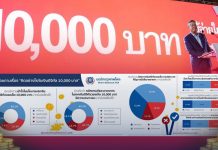The Thai society has so far been unable to grab the main point of the Sufficiency Economy initiative of His Majesty King Bhumibol Adulyadej, according to an official of the National Economic and Social Development Board (NESDB).
NESDB Deputy Secretary General Thanin Paem said the 10th national economic and social development plan (2007-2011) has adopted the philosophy of Sufficiency Economy as the guideline for action in order to move national development towards a sound equilibrium, fairness and sustainability. The five-year period of the plan covered the administrations of General Surayud Chulanont, Mr Samak Sundaravej, Mr Somchai Wongsawat and Mr Abhisit Vejjajiva. During the period people in the society were urged to apply the philosophy in their lives, in order to achieve sustainable growth, environmental protection and a better quality of life.
Towards those ends, the Sufficiency Economy philosophy has been integrated into the public sector’s plans of economic, social and environmental development as a tool to strengthen local communities. For businesses, several firms, both large and small, have adopted the Sufficiency Economy approach as a guide to management and planning. Communities also took part by enhancing self-reliance similar to the business sector. They develop long-term self-help schemes such as savings groups, revolving credit lines, and local safety nets, organizing with other communities and moving towards sustainable economic activities.
The success of the policy could be seen constructively and could immunise the financial discipline of people. As a result, the Thai economy has grown with stability while public debt ratio remains in control or below 50% of the Gross Domestic Product (GDP). Monetary policies and measures to regulate financial institutions in Thailand were imposed to reduce impact from the global financial fluctuation.
However, investment from savings in Thailand remained low and risky for long-term economic stability since it is one of the factors to help build security, cushion the impact from economic fluctuations and reduce dependency on foreign currencies. In the first three years of the 10th NESD Plan, savings shrank from 2.79 trillion baht or 32.8% of the national GDP to only 2.67 trillion baht or 29.4% of the GDP. This level of savings indeed could not respond to investment demand of the public sector, especially the Strong Thailand Scheme introduced by the Abhisit administration which needed over 1.57 trillion baht in loan for implementation.
Continue to part two to see other problems in the application of the Sufficiency Economy Philosophy and suggestions presented by the NESDB.




